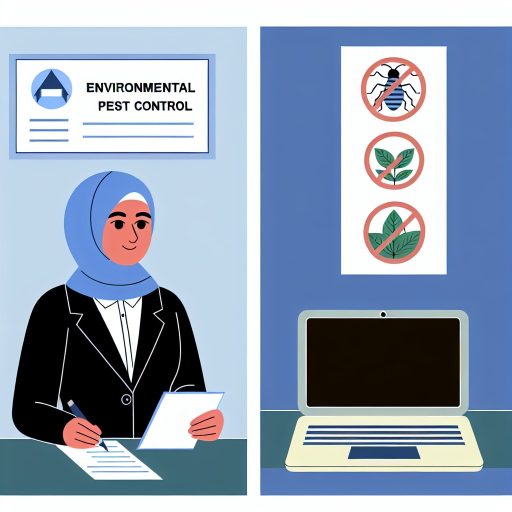Introduction
Environmental scientists play a crucial role in pest management.
They study the impact of pests on ecosystems.
Their work is essential in protecting the environment and human health.
They prevent the negative effects of pests from spreading.
Education and Training
- To become an environmental scientist specializing in pest management, a minimum of a bachelor’s degree in environmental science or a related field is typically required.
- Advanced degrees, such as a master’s or Ph.D., can provide additional opportunities for specialization and advancement in the field.
- Training in pest management techniques, including integrated pest management practices, is crucial for success in this career.
Specific Skills and Knowledge
- Strong knowledge of pest biology, behavior, and ecology is essential for effective pest management strategies.
- Understanding of chemical and non-chemical control methods, such as biological control, traps, and pesticides, is necessary for addressing pest issues.
- Skills in data analysis and interpretation are valuable for assessing pest populations and monitoring the effectiveness of control measures.
- Excellent communication skills are vital for collaborating with other professionals, educating the public, and advocating for sustainable pest management practices.
- Knowledge of relevant laws and regulations governing pest control is critical for ensuring compliance and protecting the environment and human health.
Environmental scientists are essential in pest management.
They are trained to identify and monitor pest populations.
Pest Identification
- Scientists use their knowledge of pest behavior and ecology to recognize different pest species.
- They conduct surveys and field studies to determine the types of pests present in a particular area.
- By examining pest characteristics such as morphology and behavior, scientists can accurately identify them.
- Early identification is crucial as it helps to prevent the pests from causing significant damage.
Techniques for Monitoring Pest Populations
- Environmental scientists use a variety of tools and techniques to monitor pest populations.
- One common method is the use of traps and pheromones to capture and monitor pest activity.
- They also employ remote sensing technologies such as drones and satellites to track pest infestations.
- Scientists may conduct regular field surveys to assess the spread and impact of pests on crops or ecosystems.
Monitoring pest populations allows scientists to understand the dynamics of pest outbreaks.
This understanding helps develop effective management strategies.
The role of environmental scientists in identifying and monitoring pests is critical.
They ensure timely and efficient pest management practices.
Gain More Insights: How Quality Control Inspectors Ensure Food Quality
Integrated Pest Management (IPM)
IPM is a sustainable approach to managing pests.
It combines biological, cultural, physical, and chemical tools.
This method minimizes economic, health, and environmental risks.
Environmental scientists play a crucial role in developing IPM strategies.
They focus on long-term prevention rather than reacting to outbreaks.
Scientific knowledge is essential to these strategies.
Environmental scientists identify root causes of pest problems.
They develop strategies based on sound scientific principles.
Key Principles of Implementing IPM
- Environmental scientists accurately identify pests and monitor their populations.
- They implement practices to prevent pest breeding and feeding habits.
- A combination of biological control, cultural practices, physical barriers, and least-toxic pesticides is used effectively.
- Environmental scientists continuously evaluate IPM effectiveness and adjust strategies as needed.
- They educate the public, farmers, and policymakers on the benefits of IPM.
By applying these principles, environmental scientists reduce reliance on chemical pesticides.
Transform Your Career Today
Unlock a personalized career strategy that drives real results. Get tailored advice and a roadmap designed just for you.
Start NowTheir expertise ensures pest control is effective and environmentally friendly.
They also promote economically viable and sustainable pest management in the long term.
Delve into the Subject: The Role of Biotechnology in Food Science
Research and Data Analysis
- Environmental scientists utilize various research methods to study pest behavior and ecology.
- These methods are crucial in understanding the dynamics of pest populations and their interactions with the environment.
- One common research method used by environmental scientists is field surveys.
- These surveys involve collecting data on pest populations, distribution, and behavior in their natural habitats.
- By conducting these surveys, scientists can gather valuable information on the factors influencing pest abundance and distribution.
- Another important research method is experimental studies.
- Scientists design controlled experiments to study the effects of different factors on pest populations.
- These experiments help in identifying the most effective pest management strategies and understanding the underlying mechanisms driving pest dynamics.
- Genetic analysis is also a widely used research method in pest management.
- By analyzing the genetic structure of pest populations, scientists can determine the source of infestations.
- They also track the spread of resistant genes and develop targeted control measures.
- In addition to these methods, environmental scientists also rely on remote sensing technologies.
- These technologies allow scientists to monitor changes in pest populations and their habitats over large geographic areas.
- Remote sensing data provides valuable insights into the impact of environmental changes on pest dynamics.
- Data analysis plays a crucial role in helping environmental scientists make informed decisions in pest management practices.
- By analyzing the data collected from research studies, scientists can identify patterns, trends, and potential correlations.
- These insights inform their pest management strategies.
- Statistical analysis is a key component of data analysis in pest management.
- Scientists use statistical techniques to quantify relationships between pest populations and environmental variables.
- They also assess the effectiveness of control measures and predict future pest outbreaks.
- Modeling is another important tool used in data analysis by environmental scientists.
- Scientists develop mathematical models to simulate pest populations under different scenarios.
- Models help evaluate the impact of management strategies and optimize control efforts.
- Data analysis also helps in monitoring pest populations over time.
- By analyzing long-term data trends, scientists assess the efficacy of pest management practices.
- They detect early warning signs of pest outbreaks and adjust control strategies accordingly.
Research and data analysis are essential components of pest management practices.
Environmental scientists rely on these methods to understand pest behavior, develop effective control measures, and minimize the environmental impact of pest management interventions.
Find Out More: Extension Agents: Training the Next Generation
Risk Assessment and Mitigation
- Environmental scientists assess risks by studying potential impacts of pest control methods.
- They consider factors like toxicity, persistence, and potential for bioaccumulation in the environment.
- By conducting field studies and experiments, they gather data on the effectiveness and consequences of pest control.
- Through computer modeling, they simulate the potential outcomes of different pest management strategies.
Strategies to Minimize Environmental Impact
- Choosing non-chemical or less toxic methods like biological control, trap cropping, or pheromone traps.
- Implementing Integrated Pest Management (IPM) practices that combine multiple approaches for sustainable pest control.
- Using targeted pesticides that are specific to the pest species and have minimal impact on beneficial organisms.
- Developing and promoting eco-friendly pest control products that are biodegradable and pose less risk to the environment.
Protecting Non-Target Species
- Environmental scientists conduct surveys to identify non-target species that may be affected by pest control measures.
- They assess the potential risks to these species and implement measures to reduce collateral damage.
- By using selective pesticides and application methods, they minimize harm to beneficial insects, birds, and other wildlife.
- Monitoring and evaluating the impacts of pest control measures on non-target species to adjust strategies accordingly.
Delve into the Subject: Best Practices for Agricultural Loan Underwriting

Collaboration and Outreach
Collaboration between environmental scientists and pest control professionals is crucial for effective pest management.
It also involves other stakeholders to create a comprehensive approach.
Importance of Collaboration
- Environmental scientists provide insights on ecological impacts.
- Pest control professionals offer solutions for pest infestations.
- Collaborating ensures a holistic strategy that considers environmental impact, human health, and economic viability.
- Joint projects lead to innovative pest management techniques and sustainable practices.
- Scientists and professionals exchange data on pest populations, trends, and treatment efficacy for informed decisions.
Role of Outreach Programs
- Outreach programs raise public awareness about sustainable pest management practices.
- They promote behavioral changes in households and communities.
- Workshops and training sessions help stakeholders learn eco-friendly pest control methods.
- Community participation in pest monitoring and control supports shared responsibility.
- Outreach initiatives influence policy decisions to implement environmentally safe pest management regulations.
Collaboration and outreach foster partnerships and share knowledge.
They promote sustainable pest management practices for a healthier environment.
Role of Environmental Scientists in Sustainable Pest Management Policies
Policies play a crucial role in shaping pest management practices.
They also ensure environmental sustainability.
Environmental scientists advocate for policies that support sustainable pest management.
They actively engage with policymakers, industry stakeholders, and the public.
This engagement promotes environmentally friendly pest management strategies.
- Environmental scientists conduct research to provide evidence-based recommendations for policymakers.
- They assess the impact of different pest management methods on the environment and public health.
- By studying the interaction between pests, their predators, and the environment, scientists propose innovative solutions.
- Environmental scientists collaborate with government agencies to develop regulations and guidelines for pest management.
- They ensure that policies are based on scientific evidence and prioritize ecosystem protection.
- Scientists advocate for integrated pest management (IPM) strategies combining biological, cultural, and chemical methods.
- IPM focuses on preventing pest problems through monitoring, habitat modification, and targeted pesticide use.
- Environmental scientists emphasize reducing reliance on chemical pesticides and promoting alternative methods.
- They highlight risks of pesticide use, such as contamination and harm to non-target species.
- Scientists advocate adopting organic farming and biological control methods to minimize pesticide use.
- They promote sustainable pest management to preserve biodiversity and ecosystem health.
- Environmental scientists work with farmers, industry groups, and policymakers to raise awareness about sustainable pest management benefits.
- They collaborate with international organizations to develop global pest management policies.
- Scientists participate in conferences, workshops, and policy forums to share research findings and best practices.
- Through policy advocacy, they aim to create frameworks supporting sustainable pest management and protecting public health.
Role of Environmental Scientists in Pest Management
Environmental scientists conduct research to develop innovative solutions in pest management.
Their work promotes sustainable practices and eco-friendly pest control methods.
They help identify and understand various pest issues affecting ecosystems and agriculture.
Environmental scientists research effective measures to control pests with minimal environmental impact.
Transform Your Career Today
Unlock a personalized career strategy that drives real results. Get tailored advice and a roadmap designed just for you.
Start NowTheir contributions support the overall sustainability of pest control strategies.
They ensure pest control solutions remain both effective and environmentally responsible.
Their expertise is essential in tackling pest challenges while preserving ecological balance.
Environmental scientists play a key role in promoting sustainable and eco-friendly pest management.
Their dedication helps minimize environmental harm from pest control activities.
Their involvement is indispensable in balancing pest control with environmental conservation.




